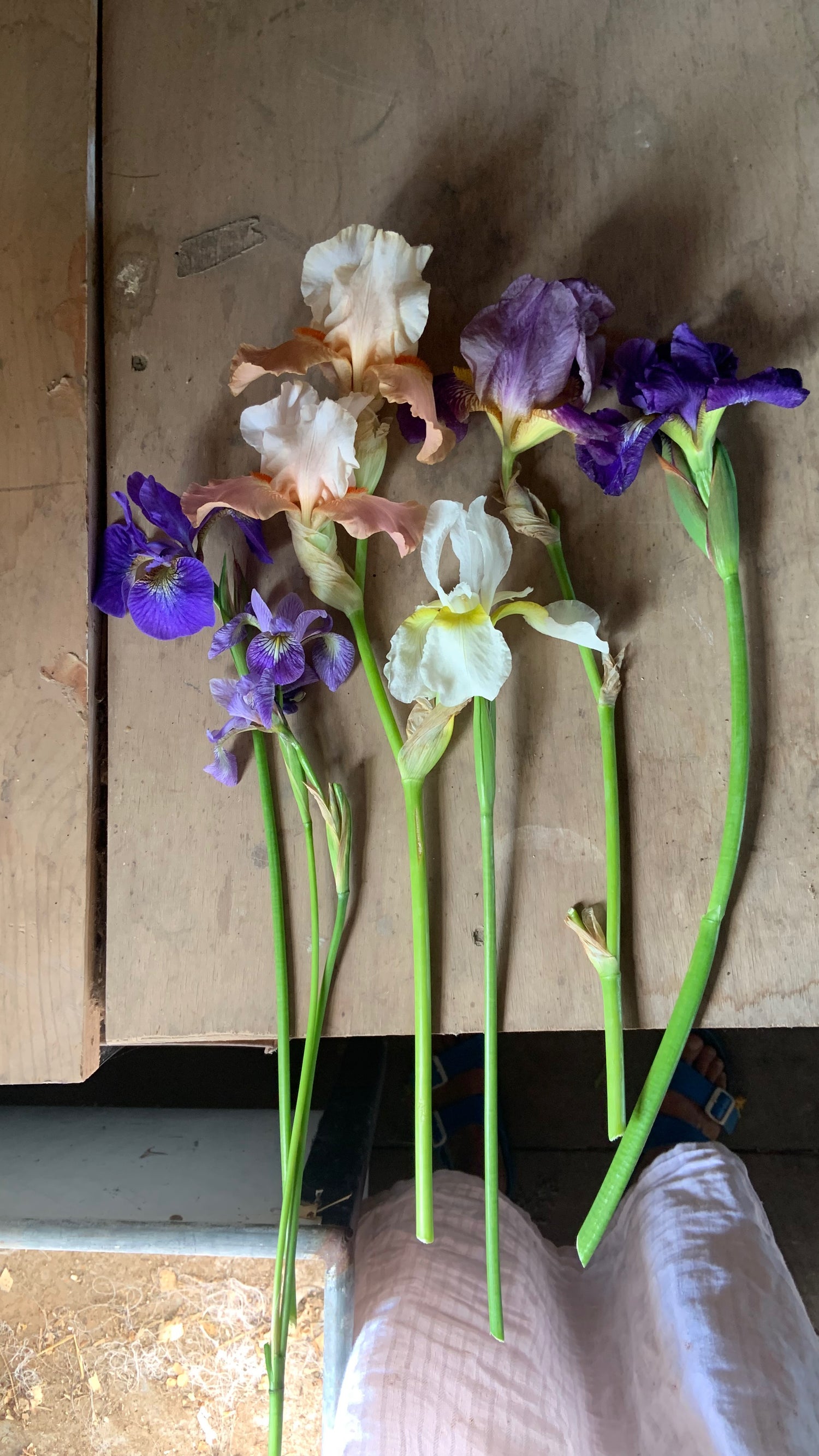
What I've Learned
Growing irises is part patience, part magic, and totally worth it. Once you get the hang of planting them in just the right spot—with plenty of sun and well-drained soil—they’re surprisingly low-maintenance and incredibly rewarding. These beauties don’t need much fuss, and they come back year after year with even more gusto.
While I’ve casually grown and divided irises for years, I’ll admit—they’ve played second fiddle to my tulip obsession. But that’s changing. I’m finally taking the time to really dig in (literally and figuratively), and harvest what I’ve learned to share it with you.
The key? Give them space, don’t bury them too deep, and whatever you do—don’t overwater. Irises like their feet dry and their heads in the sun. Below, you’ll find my go-to tips for planting, dividing, and keeping your irises happy season after season. Spoiler alert: your future self—and your garden—will thank you.
How To's
-
When to Plant
Try to plant your rhizomes soon after receiving them. Unlike bulbs, iris rhizomes don’t love sitting around in bags—they’re living roots, and they’re ready to grow. The sooner they’re in the ground, the happier (and bloomier) they’ll be come spring.
The goal is to get them in the ground when the heat starts to back off but at least 6 weeks before the first hard frost. This gives them just enough time to settle in and establish roots before winter rolls in.
-
How to Plant
First things first: choose a sunny spot with well-draining soil—this is non-negotiable. Irises love the sun and absolutely hate sitting in soggy soil. When it’s time to plant, resist the urge to bury them deep (this is the most common mistake!). Iris rhizomes like to sit right at or just barely below the surface, with their tops exposed to the sun and air.
Dig a shallow trench or hole, then make a small mound in the center. Set the rhizome on top and gently drape the roots down the sides like you're tucking them in. Space each plant about 12–18 inches apart to give them room to grow, breathe, and show off.
Give them a solid drink of water after planting to help them settle in—but after that, go easy. Irises like their roots moist, not soaked, so let the soil dry out between waterings.
-
How to Divide
Irises are incredibly generous—they’ll multiply over time, giving you more blooms and more rhizomes to share or spread throughout your garden. But every 3–5 years, they start to get a little crowded, and that’s your signal to divide.
The best time to divide irises is in late summer to early fall—the same window when you’d plant new ones. Start by gently digging up the whole clump and shaking off the soil. Look for healthy, firm rhizomes with a fan of leaves attached, and cut away any that are soft, shriveled, or damaged (especially by borers). Then trim the leaves down to about 6 inches—this helps reduce stress and makes them easier to handle.
Replant the healthiest rhizomes just like new ones: top exposed, roots spread out, and spaced about 12–18 inches apart.
It’s a bit of a garden chore (there are plenty of YouTube videos if you want a visual boost!), but totally worth the effort.
FAQ's
When will my Iris bloom?
Most irises will bloom in late spring to early summer. For newly planted rhizomes, expect about 60–75% to bloom in their first year—some may take a little extra time to get settled. I'd keep expectations at low the first year, and know they'll bloom the following spring! Patience pays off—the show gets better every year!
What kind of soil do Irises like?
Irises are pretty low maintence but they do have some soil preferences to keep them happy. They love well-draining soil—think loose, sandy, or even slightly gritty soil that doesn’t hold onto water for too long. Too much moisture around their rhizomes can cause rot, so good drainage is key. A neutral to slightly acidic pH (around 6.8 to 7.0) is ideal, but they’re fairly adaptable. If your soil is heavy clay, mixing in some compost to help lighten it up and keep those irises thriving!
Do I need to fertilize Irises?
What kind of fertilizer you use really depends on your soil, but low-nitrogen options like a 6-10-10 mix, bone meal, or superphosphate usually do the trick. A light sprinkle in early spring—around the time tulips start blooming nearby—and another one about a month after your irises finish blooming will keep them happy and healthy. Just steer clear of anything high in nitrogen; irises don’t like it and it can mean lots of leafy growth but fewer flowers.
What is a reblooming Iris?
A reblooming iris is a variety that blooms twice in one growing season. You’ll get the main bloom in spring or early summer, and then a second, usually smaller, bloom in late summer or early fall. It’s a nice bonus that keeps your garden colorful for longer—just a little extra show from these hardworking plants!
My Iris didn't blossom. Now what?
Irises are a bit like us—they just want a little space and the right care to shine. If your irises aren’t blooming, it’s usually a mix of a few common things: maybe they’re stuck in too much shade (they love at least 6 hours of sun), planted too deep (their rhizomes like to peek out a bit), or getting too much—or too little—fertilizer. Mulching with lawn clippings or other wet stuff can make them unhappy, and watering can be tricky too—they like well-drained soil and a good soak every week or two during dry spells. Oh, and don’t forget to give them some breathing room by dividing them every 3 to 5 years. With just a bit of TLC, your irises will reward you with beautiful blooms!